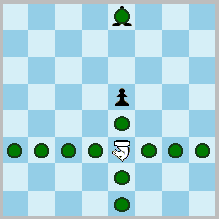Gustavian Cannonrider Chess
This page contains one or more presets for playing a game online with Game Courier, an online server for playing Chess variants by correspondence.
In Gustavian Cannonrider Chess "Cannonriders" are placed on the Bishop files (and Knights are placed on the four extra corner squares of the Gustavian board). The Cannonrider moves differently depending on the colour of the square. On black squares it moves like a Cannon: it slides like a Rook, but can capture an enemy only if there is another piece (of either side) in between, and any interim squares are empty. Thus to capture it leaps over the intervening piece and lands on the enemy piece, like a cannonball. If positioned on a white square it jumps like a Nightrider, that is, can make continuous knight jumps in the same direction, provided that the interim squares are empty. Note that the Kings are initially positioned on the d-file. Otherwise, the rules are the same as in standard chess, except for the possible pawn promotion to Cannonrider.The Cannonrider's value is 5, that is, the same as a Rook. The Cannonrider's image also changes when it moves to a square with a different colour (it rotates). This makes it easier to understand the piece. The Cannonrider is a very interesting piece for the tactician. Positionally, too, it could be quite dangerous because one can sometimes sacrifice a Cannonrider for a light piece (Knight or Bishop) to achieve positional ends. In the middlegame the Cannonrider is more valuable than a Rook, due to its dangerous tactical capabilities. But in the endgame it is less valuable than a Rook. An obvious case is the endgame King + Cannonrider vs. King, while it cannot give mate to the enemy King. Watch out for fool's mates in the opening. If the Cannonrider is placed on a black square on the king's file, then it could mean mate. There is no way for white to secure an advantage by an immediate activation of a Cannonrider.
The Cannonrider was invented by undersigned, but the cannon movement derives from the Cannon in Chinese Chess (Xiangqi). The Nightrider movement was invented by the British chess problem composer
 The Cannonrider, standing on a white
The Cannonrider, standing on a white square, can jump like a knight, but
also has the continuous knight jumps.
 The Cannonrider, standing on a black
The Cannonrider, standing on a black square, can slide like a rook. But it can
only capture by jumping over any
intervening piece and landing on an
enemy piece.
As the Cannonrider alters between Cannon moves and Nightrider moves the piece image in the preset will be different depending on square colour. This will make it easier. If the Cannonrider stands on a black square, it is denoted by CC (as in Cannonrider-Cannon). If the Cannonrider stands on a white square, it is denoted by CN (as in Cannonrider-Nightrider). Use small characters for black.
The following preset makes a reasonably good validity check of Cannonrider moves, etc. Moves are automated, including castling and the 'en passant' move. Pieces can be moved by pointing and clicking. When promoting a pawn, it will automatically turn into a Queen. Should you prefer another piece then you must type it manually (e.g., add N a8; capture a7). Use small piece-letters for black. E-mails to your opponent are generated, but you can play online by intermittently pressing the browser's update button.
Gustavian Cannonrider Chess
You can also download a Zillions implementation  here.
here.
See also my other Game Courier presets.
 This 'user submitted' page is a collaboration between the posting user and the Chess Variant Pages. Registered contributors to the Chess Variant Pages have the ability to post their own works, subject to review and editing by the Chess Variant Pages Editorial Staff.
This 'user submitted' page is a collaboration between the posting user and the Chess Variant Pages. Registered contributors to the Chess Variant Pages have the ability to post their own works, subject to review and editing by the Chess Variant Pages Editorial Staff.
By M Winther.
Web page created: 2006-07-20. Web page last updated: 2006-07-20
